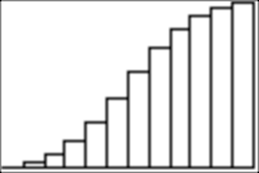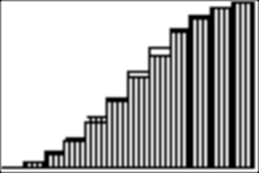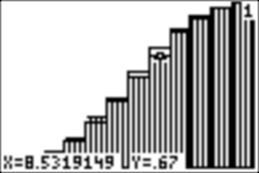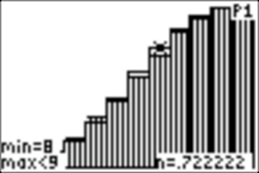Cumulative distributions with dice
First, a review. Earlier
we computed the theoretical frequency distribution for throwing two dice. It looks like this:

Another
way to look at the data:
Theoretical
probability of the 11 outcomes from tossing two dice
|
outcome |
2 |
3 |
4 |
5 |
6 |
7 |
8 |
9 |
10 |
11 |
12 |
|
frequency (fraction) |
1/36 |
1/18 |
1/12 |
1/9 |
5/36 |
1/6 |
5/36 |
1/9 |
1/12 |
1/18 |
1/36 |
|
frequency (decimal) |
.0278 |
.0556 |
.0833 |
.1111 |
.1389 |
.1667 |
.1389 |
.1111 |
.0833 |
.0556 |
.0278 |
We
discovered that when we randomly toss two dice, we rarely if ever get the
theoretical distribution. Instead, we get an empirical distribution that
differs from the theoretical one. When we
used the program DICETOSS, we saw that most often, if we kept rolling, our
whole distribution of observed frequencies came fairly close to the theoretical
probabilities.
But now
we want to do something different with our calculators. We will program the calculator to draw an
empirical bar graph of the CUMULATIVE tosses of two dice, namely, a cumulative distribution
of the empirical outcomes.
What is
a cumulative distribution? For every number x, you count the total number of
data points (here, the number of throws) smaller than or equal to x. For
example, if we have the list {2, 4, 6, 2, 3, 5}, and x = 4.5, the number of
data points smaller than or equal to x is four (they are 2, 4, 2, and 3).
We can
put any set of numbers into list LD. Let’s simulate throwing two dice 200 times. We store the data in list LD. First, store in LD the result of 200 throws of one die:
randInt(1,6,200) → LD
Now let’s add to the list the result of 200 throws of
the second die:
randInt(1,6,200)+ LD → LD
In your
calculator, enter

LD≤X
returns the value one for any element of the list LD which is less than or equal to X. Y1 computes the frequency, a number between 0 and
1.
To set
the window:
Xmin=min(LD)-1
Xmax=max(LD)+1
Ymin=0
Ymax=1
Be sure
to set Axes off and Plots off. Now
GRAPH
This is
what I got. Does yours look something
like it?

It is
called a cumulative distribution.
Let’s explore it with TRACE. For example, for X
between 7 and 8, TRACE shows the decimal number of throws yielding 2, 3, 4, 5,
6, and 7.

Suppose
we want to know the percentage of throws with individual (not cumulative)
outcomes of 2, 3, 4, 5, 6, 7, 8, 9, 10, 11, and 12. We do it this way:


Each
time we press enter, we see the outcome and the percentage of throws in list LD
with this outcome.
Now let’s make another empirical cumulative
distribution with two dice, as we did earlier:
randInt(1,6,200) → LD
randInt(1,6,200)+ LD → LD
Now in
Y=, change Y1 to look
as follows:

Then
GRAPH
Here is
what I see. What do you see?

You may
explore the values using TRACE, as we did above. Here is an example from my run:

How does
this empirical distribution compare with the cumulative probability
distribution for tossing two dice? Let’s look at the theoretical cumulative
distribution numerically:
Theoretical
cumulative probability of the 11 outcomes from tossing two dice
|
outcome |
2 |
3 |
4 |
5 |
6 |
7 |
8 |
9 |
10 |
11 |
12 |
|
frequency (fraction) |
1/36 |
1/12 |
1/6 |
5/18 |
5/12 |
7/12 |
13/18 |
5/6 |
11/12 |
35/36 |
1 |
|
frequency (decimal) |
.0278 |
.0833 |
.1667 |
.2778 |
.4167 |
.5833 |
.7222 |
.8333 |
.9167 |
.9722 |
1 |
You can
also graph the cumulative probability distribution:

(Can you
figure out how to do it? I used StatPlot.)
And you
can graph the cumulative probability distribution and the empirical frequency
distribution on the same screen:

Further,
you can investigate both graphs with TRACE:


P1 is
the cumulative probability distribution and 1 is the empirical frequency
distribution.
Your task.
Make an
(empirical) cumulative distribution graph on your TI-83/84 for 200 tosses of
THREE (or four; you can choose) dice, and show it to the instructor.
How do
you set the calculator window? (What is
the lowest outcome you can throw with 3 dice? Set Xmin
equal to this value minus 1. What is the highest? Set Xmax
equal to this value plus 1. Ymin is 0 and Ymax is 1.)
Return